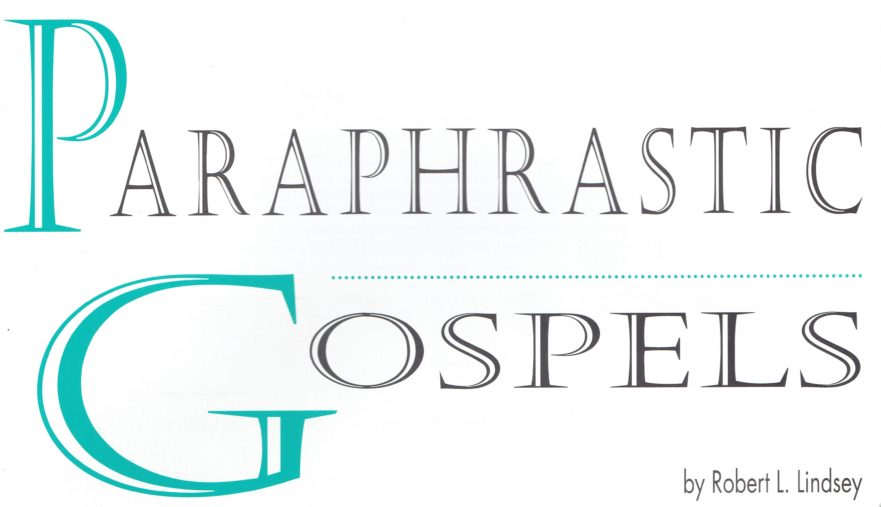
The four Evangelists of the Greek New Testament, though concurring at many points, demonstrate a remarkable degree of disparity when retelling their versions of the life of Jesus. This is especially true of Mark and John.[11] Their accounts are very early Greek paraphrases of the gospel records.[12] Mark’s Gospel predates John’s by about forty years, and it will be the Markan paraphrastic method that will occupy our attention here.
When reading Matthew, Mark and Luke in modern translation, a reader generally cannot see the differences in wording of the underlying Greek texts. This is because the differences are often synonymic. If perceptible at all, they can easily escape notice. In scores of places, where Luke used a certain word or phrase, Mark used an equivalent, but different word or phrase. The best way to grasp how Mark operates is to look at examples from the Gospels themselves.
Markan Synonyms
In Matthew 9:1-8, Mark 2:1-12 and Luke 5:17-26, there is a story about a paralytic who is carried to Jesus on some sort of stretcher. Matthew and Luke agree against Mark that the paralytic was carried on a κλίνη (kline).[13] Mark has chosen κράβαττος (krabattos) as a synonym.[14] The variance is reflected in the New American Standard Bible. Kline is translated as “bed” and krabattos as “pallet.”
Premium Members and Friends of JP must be signed in to view this content.
If you are not a Premium Member or Friend, please consider registering. Prices start at $5/month if paid annually, with other options for monthly and quarterly and more: Sign Up For Premium
Editors’ note: Out of esteem for our teacher, Robert Lindsey, we have collaborated to make this article and his “Unlocking the Synoptic Problem: Four Keys for Better Understanding Jesus” (Jerusalem Perspective 49 [Oct.-Dec. 1995], 10-17, 38) available to our readers. These articles mark the end of Robert Lindsey’s scholarly career. With his health waning and incapacitated by a series of strokes that accompanied the diabetes from which he suffered, Dr. Lindsey was able to complete only a first or second draft of each article. Though we could not preserve Dr. Lindsey’s writing style, great effort was made to preserve faithfully the content of his articles. We are responsible for the articles’ conclusions and footnotes. — David Bivin and Joseph Frankovic

- [1] The change from proselthousa to elthousa in Mark 5:27 and the change from kline to krabattos in Mark 2:1-12, both examples from the Triple Tradition, are places where Matthew and Luke agree against Mark. Such agreements are termed "minor agreements" by scholars. For the significance of these minor agreements against Mark, see Nigel Turner, "The Minor Verbal Agreements of Mt. and Lk. Against Mk.," Studia Evangelica 73 (1959): 223-234; and E. P. Sanders, "The Overlaps of Mark and Q and the Synoptic Problem," New Testament Studies 19 (1973): 453-465. ↩
- [2] The Greek κράσπεδον (kraspedon) is used in the Septuagint to translate the Hebrew צִיצִית (tsitsit, tassel). Cf. Numbers 15:38. Matthew and Luke make clear that the woman touched the braided tassels that were attached to the corners of an observant Jew’s garment. ↩
- [3] Some scholars term the additional details provided by Mark "Markan freshness" and view such additions as evidence of the primitive nature or originality of Mark. These extra details, however, are often lifted from other books of the New Testament or the Septuagint. Already at the turn of the twentieth century Benjamin Bacon had noticed Mark’s habit of lifting material from other sources. See Bacon’s comments to Mark 1:1 (Hosea 1:2, LXX), Mark 1:13 (Naphtali 8:4), Mark 6:13 (James 5:14), Mark 6:23 (Esther 5:3), and Mark 7:19 (Acts 10:15; 11:9) in The Beginnings of the Gospel Story: A Historico-Critical Inquiry into the Sources and Structure of the Gospel According to Mark, with Expository notes upon the text, for English Readers (New Haven, CT: Yale University Press, 1909), 8, 13, 66, 75, 89. ↩
- [4] Cf. Matt. 11:7-19 and Luke 7:24-35. ↩
- [5] In most English translations all three synoptic writers appear to agree upon the words of the heavenly voice: "You are my son, my beloved. With you I am well pleased." Yet, there is a variant reading for Luke 3:22. This reading is attested by the fifth-sixth-century Codex Bezae Cantabrigiensis manuscript, the Old Latin manuscripts, the Gospel of the Ebionites, and by several church fathers. The variant reading is, "You are my son. Today I have begotten you." This is a quotation from Psalm 2:7 and is much more suitable in the context of Jesus’ baptism, the commencement of Jesus’ public ministry. Luke’s text was likely "corrected" by a scribe to bring it into alignment with Matt. 3:17 and Mark 1:11. This scribal tendency of aligning the wording of one synoptic text with the other two can be seen in numerous places, if we pay close attention to the readings of the various New Testament manuscripts.
For a discussion of this variant reading, see Alfred R. C. Leaney, A Commentary on the Gospel According to St. Luke, in Black’s New Testament Commentaries (London: Adam and Charles Black, 1958), 110-111. Though agreeing with the editors of the United Bible Societies’ third corrected edition, who accept the reading, "You are my son, my beloved. With you I am well pleased," Joseph A. Fitzmyer has a helpful discussion of the variant in The Gospel According to Luke (I-IX), The Anchor Bible, Vol. 28 (Garden City, NY: Doubleday & Co., 1981), 485. ↩
- [6] Mark may have been influenced by Luke 20:13 in his choice of "beloved." ↩
- [7] Shmuel Safrai, "Spoken Languages in the Time of Jesus,"Jerusalem Perspective 30 (Jan./Feb. 1991): 8. Note that Stephen also quoted from Psalm 31:5 as he was being put to death (Acts 7:59; cf. John 19:30), and Peter exhorted those who were sharing the sufferings of Jesus to commit their souls to God (1 Pet. 4:19). ↩
- [8] Cf. The Authorized Daily Prayer Book, ed. Joseph H. Hertz (rev. ed.; New York: Bloch Publishing, 1948), 1065. ↩
- [9] See Joseph Frankovic, "Pieces to the Synoptic Puzzle: Papias and Luke 1:1-4," Jerusalem Perspective 40 (1993): 12-13. ↩
- [10] Saul Lieberman,Greek in Jewish Palestine/Hellenism in Jewish Palestine (New York: The Jewish Theological Seminary of America, 1994), 50. ↩
- [11] A rule of thumb is: Opposite a parallel story in Luke, Mark will change up to fifty percent of Luke’s words; where Matthew has a story parallel to Mark, Matthew will copy about seventy percent of the words found in Mark, but give, against Mark, about ten percent of the words Luke uses; where John has a story parallel to one found in the synoptic tradition, he will have phrases reflecting one or more of the synoptic documents, resulting in a mixing of the words, especially the words of Mark and Luke—less often copying readings from Matthean parallels. ↩
- [12] One helpful way of viewing John’s Gospel is in light of the Book of Deuteronomy. Deuteronomy is a retelling of the Exodus and wilderness experience. It is a theological reflection on the past and a restating of the commandments, to prepare the Israelites for the transition from a nomadic to an agriculturally based, sedentary lifestyle. In particular, certain aspects of the biblical commandments were developed and emphasized to meet new challenges. The Gospel of John is similar. It represents a theological development in the presentation of who Jesus is. Moreover, John’s method is freer than Mark’s. ↩
- [13] Cf. Matt. 9:2 with Luke 5:18, and Matt. 9:6 with Luke 5:24. In Luke 5:24 the word κλινίδιον (klinidion, a little bed), the diminutive of κλίνη (kline), is used. ↩
- [14] Cf. Mark 2:4, 11. ↩


![Robert L. Lindsey [1917-1995]](https://www.jerusalemperspective.com/wp-content/uploads/userphoto/28.jpg)
